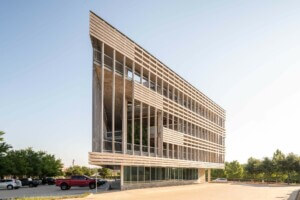In recent years, architects and fabricators in the field of facade design and construction have formed new collaborative relationships through the design assist model of contracting. Under design assist, the fabricator contributes their know-how throughout the design process, not just during building. A couple of factors have encouraged the shift to design assist. On the one hand, “the recent increase of building skin complexity has been a driver of this new way of working,” explained Enclos’ Luke Smith. “But I think budget and schedule demands have also played an important role.”
Next week, Smith will moderate a panel on design assist contracting, “Delivering Complexity,” at Facades+ LA. With panelists Bill Kreysler (Kreysler), Paul Martin (Zahner), and Kerenza Harris (Morphosis), Smith will explore several case studies of architect-fabricator collaborations, and will examine the benefits and challenges of these new alliances. (Smith is also leading a dialog workshop, “Material Explorations: The Resurgence of Wood,” on the second day of the workshop.)
Because design assist encourages early and frequent communication between architect and fabricator, said Smith “all of the involved parties feel invested in the project.” Collaboration also improves the likelihood that a design is actually built. “Working together toward a buildable solution can often mean the difference between whether a project moves ahead or not,” said Smith. “At Enclos we’re seeing that the discrepancy between design intent and budgetary restrictions can be minimized through early involvement on a project.” As for the criticism that design assist removes control from the architect, he argued, “given the intricate knowledge required, the facade is no longer simply a byproduct of design, but is a specialty of its own.”
Smith and the rest of the panel will focus on two examples the group knows well: Morphosis’ Emerson College Los Angeles Center (with Zahner), and Snøhetta‘s San Francisco Museum of Modern Art. The museum expansion, said Smith, “has been a great opportunity for Enclos, partnering with Kreysler, to explore solutions with Snøhetta from a very early stage of facade conception.”
Regarding the future of design assist, “increased communication between the two ‘sides’ of architecture and construction will only benefit everyone in the long run,” said Smith. “Whether we need to collaborate on all projects is another question. Where we really see the process take center stage is when a new challenge arises.”
To hear more about design assist from some of the AEC industry’s top experts in building envelope design and construction, register today for Facades+ LA. More information, including a complete symposium agenda and lineup of tech and dialog workshops, is available online.










